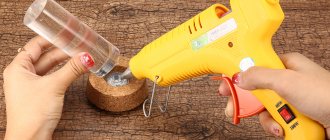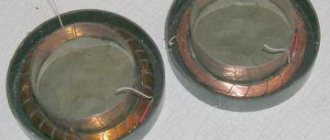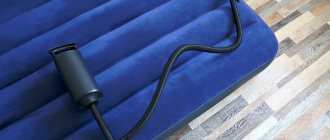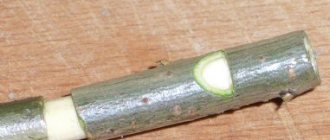Soldering iron (apparatus) for welding polypropylene pipes (ASPT)
– this is an electric tool designed for welding (fusion) of water and heating pipes made of polypropylene. The tightness of the pipe connection is ensured by melting the contacting surfaces, inserting a pipe with a smaller diameter into a pipe of a larger diameter, followed by cooling.
Industrial production of polypropylene pipes began in 1958 in the USA and Italy. Since then, pipes have been constantly improved and, thanks to their high technical characteristics, compared to iron pipes, they have conquered the whole world. The ease of connection and the absence of the need to use open flame during installation made the work safe. For a sealed connection, a special electrical device is used, the repair of which will be discussed.
Installation instructions
- Before starting work, it is important to decide on the location of the pipes. It is advisable to make a plan on paper to reduce the number of welding “on the fly”. It will be much more convenient to assemble the main elements on the table, and then secure them into the system in several steps.
- To connect polypropylene pipes, the edges of the elements are heated. The inner wall is heated in the coupling, and the pipes are heated on the outside. To do this, they are almost completely put on the soldering iron nozzle and held for several seconds.
- After this, the elements are immediately connected in the desired direction. You'll have a couple of seconds to center them if necessary, usually done by eye. In this case, you cannot rotate them internally in relation to each other. Welding time depends on the thickness of the plastic and the width of the seam.
- The heated polypropylene will mix at the joint, and will weld securely if it is heated to the desired temperature. It is also impossible to keep it on the soldering iron for too long, the plastic may leak, the internal diameter of the channel will decrease, and the tightness of the connection will be compromised.
Before soldering polypropylene pipes, be sure to open the valve on the coupling, otherwise air will push it out of the soldering iron nozzle.
- If the connection is correct, some of the plastic should come out evenly, forming a slight overhang on the coupling. If problems arise when putting on and the plastic bends too much, you need to chamfer the edge.
According to German standards DVS-2207-1, stripping for polypropylene pipes should have an angle of 15° and a recess of 2-3 mm. In Russia, the standard is a chamfer bevel of 45° and a recess of 1/3 of the thickness. In fact, any bevel within these limits will do. The main thing is that it is uniform.
Manual pipe cutter
- The welding machine for soldering must be placed on a stand (special clamp). You need to set the temperature on the regulator to 260°C, but for speed of work you can increase it to 280°C. Other temperatures will lead to an unreliable connection, so when purchasing a device it is not necessary to choose a model with a thermostat.
- The elements will be difficult to fit onto the heating nozzle because they have a larger radius. When putting them on, you can turn them a little along the axis to make it easier to put on the nozzle. However, the pipes cannot be inserted all the way, so that their ends do not melt inside. At first, to avoid this, you should make marks with a pencil, but then it will not be difficult to feel the desired depth.
- When all the elements are assembled, you can start hanging welding. Usually these are transitions between walls, connections to batteries, water supply inlets.
Regular plastic pipes are only suitable for cold water, they are not designed to work under pressure. When installing pipelines and heating, only reinforced polypropylene pipes must be used. To weld them, you will need to remove part of the reinforcement with a special shaver.
Shaver for cleaning edges from reinforcement
- If the pipes are suitable for the boiler, there should be no plastic nearby. To “keep it out”, pipes are connected using an adapter from a welded joint to a threaded one, through a metal pipe more than 0.5 m long.
- Do not forget to install a shut-off valve before the new section of the pipeline, this will help when repairing or installing a new point.
- Starting a new section will show whether the soldering process was completed correctly. After opening the shut-off valve and letting water into the system, check all connections for leaks.
Connecting metal with polypropylene
During repairs, situations often arise when a new section of polypropylene needs to be connected to old metal pipes. This connection is made using special fittings. If a fitting is soldered to polypropylene with a soldering iron, then when connecting to a metal pipe, you can go in two ways. You can weld the pipe to the fitting using a welding machine, or you can cut a thread on the pipe and screw the fitting. It’s easier to weld, but you need a welding machine, so you usually cut a thread on the pipe. Before the joining operation, the iron section is cleaned and lubricated with grease.
The use of polypropylene pipes allows you to hide them inside the wall, unlike screw metal pipes. It is first important to ensure that the connections are tight. Now you know how to properly solder polypropylene pipes, and you can easily do it yourself. Practice on small scraps first, and you'll quickly be able to update your home's plumbing.
Plastic plumbing has come into our everyday life for a long time. An invariable attribute of the renovation of the Soviet housing stock, along with metal-plastic windows, was a water supply system made of polypropylene pipes.
The advantages of polypropylene water supply over steel pipes are obvious:
- Cheapness and wide selection of materials;
- Simplicity of work on marking and assembling the most intricate and complex pipe routing options;
- Environmental friendliness, resistance of the material to corrosion and salt deposits on the walls of polypropylene communications.
Those who have encountered the tedious and time-consuming procedure of installing a water supply system from metal pipes can appreciate the simple technique of joining plastic using a special soldering iron for polypropylene pipes.
If the time has come to renovate the apartment, the problem of replacing the water supply with plastic communications, depending on the availability of desire, money and free time, can be solved:
- Hiring a craftsman and a friend who has experience working with a device for soldering propylene pipes, who can help assemble pieces of plastic pipes marked and cut into a single whole using a soldering iron;
- Transferring the issue of turnkey repairs to a team of repairmen without any desire to understand the intricacies of assembling and soldering plastic components;
- Doing all the work yourself.
The simplicity of assembling the soldering of plastic is so captivating that it is difficult to resist the temptation and solve the problem of plumbing in no other way than to choose and buy a soldering iron for polypropylene pipes.
The amount of money spent on purchasing the tool will be less than the cost of the specialist’s services, but provided that you really understand how to choose a soldering iron for polypropylene pipes. Essentially, a soldering iron for propylene parts and connecting fittings is a heating element with a thermomechanical or electrical heating control and indication system. Two nozzles are mounted on the heater, allowing you to simultaneously heat the outer surface of the pipe and the inner surface of the fitting with a soldering iron. Heating lasts on average about 5 s, the parts are connected with slight manual pressure to set and form a strong connection within 2-3 s. If parts are overheated or connected lopsidedly, some of the molten plastic may get inside the pipe, and as a result, the flow area decreases.
Important ! By performing most of the soldering and assembly work yourself, you are able to personally control the quality of soldering of polypropylene pipe joints.
For innovators and DIY enthusiasts, you can assemble a soldering iron for polypropylene pipes with your own hands. The strength and durability of the soldering depends on the perfection of the soldering iron and how high-quality the polypropylene pipes are.
Scope of application
The area of use of the soldering iron for plastic pipes is welding of pipeline elements made of polypropylene and PVC, including those with aluminum reinforcement
When working, it is important to observe the temperature regime:
- for PPR pipes, the nozzles must be heated to 260°C;
- for PVC pipes, the working part is heated to 220°C.
It is important to have a thermostat
The thermostat allows you to maintain the required heating level throughout the installation process. The indicator that goes out indicates that the device has entered operating mode.
The models on sale are divided into household and professional. Household ones are characterized by less power, they rarely have more than two holes on the heating plate and the number of nozzles is limited - the maximum diameter does not exceed 63 mm (usually up to 40 mm). Professional devices are more powerful, they allow you to simultaneously heat several sets of nozzles and the choice of their diameters is much wider, up to 100 mm.
In most cases, a household model is sufficient for independent installation of utilities in an apartment or private house. But if the project involves pipelines with a diameter of more than 32 mm, make sure that the welding unit you choose is equipped with the appropriate attachments.
What is good about a DIY soldering iron?
The operating principle of the soldering iron is simple and uses the principle of adhesion of the soldered surfaces of polypropylene parts heated to the softening temperature. There is not always a need to re-wire or re-solder half of the water supply wiring in the house. Sometimes you need to work with a soldering iron to make two or three connections. In this case, a homemade, do-it-yourself mini-soldering iron for polypropylene pipes from a handy heater can help out.
For a person with experience working with electrical wiring and plumbing skills, making a small amateur version of a soldering iron for polypropylene pipes is a matter of two hours.
As a rule, water pipes are laid in channels and hidden from prying eyes with screens and decor, so you don’t have to worry about beauty and aesthetic appearance. Another thing is important - incorrect temperature adjustment and overheating of the pipe or fitting material, even under slight force, will lead to defects. In soldering, the first and main issue remains the quality of the connection of parts.
If, when working with a homemade soldering iron, you may slightly fall short of world standards of appearance, it doesn’t matter; for amateur cases, this is acceptable.
To assemble a homemade propylene pipe soldering iron you will need:
- The heating element is the soleplate of a regular electric iron, preferably in the form of a closed aluminum block with a thermostat and an electric cord with a plug;
- soldering iron attachments for polypropylene pipes and fittings of the required size for your pipes;
- nickel-plated M8 bolt-nut for attaching nozzles to the heater;
- digital multimeter with external thermocouple thermometer;
- a clamp or other fastening that allows you to securely fix the soldering iron on a utility surface.
In addition to temperature, the speed or power of heating the surface of the parts being joined is important. If you heat a polypropylene fitting or pipe for a long enough time, the parts will lose their shape and geometric dimensions under the influence of temperature.
Therefore, to quickly melt a surface with a diameter of 15-30 mm, a power of 700 - 900 W is required, which approximately corresponds to the maximum power of the iron heater.
We assemble a homemade product for propylene couplings:
- At a distance of 30-40 m from the nose of the aluminum sole, we drill a through hole with a diameter of 8 mm and, using a screw and nut, connect the nozzles for the pipe and fitting to the base of the heater;
- We install the iron handle on the heater sole so that it does not limit access to the attached attachments;
- We connect the wiring to the contacts of the iron heater;
- We turn it on and use a multimeter, a digital thermometer and a regulator on the iron to set the temperature to 265 o C.
We use a clamp to fix a homemade soldering iron of polypropylene pipes, which will allow you to solder parts yourself, without an assistant; the handle can also be made to suit you for the greatest convenience and minimal risk of getting burned.
Which soldering iron is better for polypropylene pipes
It has always been believed that the best tool is a professional version, designed for long-term use and with high parameters for soldering propylene pipes. A professional soldering iron for polyethylene pipes requires:
- The use of materials for nozzles that are resistant to prolonged heating, with high thermal conductivity, and that do not stick to the heated surface of the polypropylene part; as a rule, brass or copper nozzles coated with Teflon or carbon are used;
- Easy and convenient change of nozzles on the heater flange; the kit includes a set for the main pipe sizes - from 16 to 160 mm;
- The metallized surface of the nozzles gives a high heating rate of polypropylene parts;
- The presence of a heater power supply stabilizer and automatic temperature regulation allows you to keep the soldering iron hot for as long as desired without the risk of failure of the heating element.
Mandatory attributes of professional models of soldering irons are an easily removable stand and a case for storing and carrying the device with accessories.
For your information ! For original models of soldering irons, unlike fakes, markings and information about the model are applied typographically to the body or to a metal substrate plate tightly sealed into the plastic. On fakes, the marking is pasted in the form of a metallized label and is easily separated from the soldering iron body.
For example, the widely known version of the soldering iron for polypropylene pipes is dytron or ditron - as you like. It is highly rated for its reliability and ease of use, unpretentiousness and robust construction. When soldering propylene parts, time passes by seconds; you have to quickly set up, drop or even throw the pin on the stand, and this practically does not affect its performance. There are three models in the DYTRON line:
- With a power of 850 W, the most popular in apartment renovations, it is used for polypropylene pipes with a diameter of up to 36 mm;
- Power 1200 W - for polypropylene pipes with a diameter of up to 160 mm;
- With a rod-shaped heater with a power of 650 W.
The soldering iron comes with a key for changing tips, which can be from 3 to 12 in a set, scissors for cutting polypropylene pipes, a building level, gloves and a stand. Despite all the advantages, it is worth noting one negative point - the clearly overpriced soldering iron.
Important ! Such devices are designed for many hours of operation, but in any case, they require careful care of the non-stick coating on the nozzles. Teflon is very sensitive to scratches and chips, so you should not use hard or metal objects other than rags for cleaning.
But even specialists involved in soldering water pipes do not always strive to buy a soldering iron for polypropylene pipes in an expensive professional version. Many of the budget models, assembled from Chinese or Turkish components, work just as well as branded models.
Let’s take, for example, a typical repairman’s workhorse—the Soyuz soldering iron for polypropylene pipes:
- High heater power - up to 2 kW;
- The kit includes six standard nozzles with a diameter from 20 to 63 mm;
- In addition, the soldering iron is equipped with a hexagon wrench for changing the working tool, a stand for the device and a case.
The length of the power cord is only 130 cm, which is clearly not enough for work. But this size is typical for budget models, while professional soldering irons have a full 2.5-3.5 m. "Soyuz" is equipped with a two-mode push-button heating control system and two color indicators - green and red, the latter lights up when the heating is turned on automatically.
The soldering iron is equipped with everything necessary for successful soldering of polypropylene pipes, so it is difficult to say whether it is worth overpaying for additional accessories, as is the case with expensive soldering iron models.
Pipes and fittings made of polypropylene can be said to be in trend today. They are used for indoor plumbing and heating wiring and networks inside houses and apartments. The popularity of this material is primarily due to the ease of working with it. Unlike metal pipes, they do not need to be bent with a pipe bender, threaded, or welded. All the labor intensity of this profession became a thing of the past with the advent of such material as polypropylene. The main tool for working with polypropylene products is an electric soldering iron or iron. In the factory kit it is equipped with sleeve attachments for soldering pipes and fittings of standard diameters. They can also be purchased separately. But there are times when, for some reason, a factory soldering iron is not available and there is no way to buy it, and of all the parts, only welding attachments are available. This is where a homemade plumbing soldering iron comes in handy.
This homemade product is one of those “blow, spit, and do the job.” You can literally assemble it on your knees from an old iron and a wooden block. With such a homemade heater you will definitely save the situation and cope with soldering polypropylene pipes. And now we’ll show you how to do it.
Connection Tools
The main tool used to join plastic pipes is a welding iron. This is a kind of soldering iron that operates from a 220V network. The principle of operation of the device is quite simple. The role of the heating element of the iron is performed by a welding heating element placed in a metal casing.
It heats the stove to a predetermined temperature, which heats the nozzles. The thermostat is responsible for maintaining the optimal temperature of the nozzles. Soldering and typical mistakes made when joining polypropylene pipes are discussed in the following article, which we recommend that you read.
The iron is a compact and lightweight welding device, equipped with seats for placing a sleeve for pipes and a mandrel for shaped products
The iron comes with heating attachments of standard sizes. Heating to a certain temperature, they soften propylene to a viscosity that will ensure a tight connection of the elements.
Nozzles are selected depending on the diameter of the pipes used:
- Size 20 – for pipes with a diameter of half an inch;
- 25th – for products with a diameter of 0.75 inches;
- 40th - for elements with a cross section of 1.25 inches.
Since the cost of such a welding machine is quite high, and it is not necessary to use it very often, there is no point in purchasing equipment. It is better to rent the tool for a day or two.
For high-quality cutting and preparation of welded areas, it is best to use a special tool designed for this purpose - a pipe cutter. With its help you can get an even, smooth and beautiful cut.
The role of the cutting element of the pipe cutter is performed by a stainless steel blade; For ease of use, the tool is equipped with a rubberized handle
In the absence of a pipe cutter, the work can be done with a grinder or a hacksaw. The only thing is that after such tools a fringe remains at the cut site. But it won’t be difficult to remove by sanding it with a strip of sandpaper.
In addition to the basic tools for the work, you will also need:
- square;
- construction tape;
- a simple pencil or marker.
When planning to connect pipes using the “cold” welding method, it is necessary to purchase in advance a thermoactive adhesive made on the basis of polyester or epoxy resin, or its thermoplastic analogue made on the basis of rubber.
What you need to assemble a soldering iron
- An old iron with a working heating sole;
- Wooden block, approximate cross-section 40x50 mm, length 40-50 cm;
- Four self-tapping screws, 3x14-16 mm;
- Sleeve attachments for a plumbing soldering iron with a clamping bolt;
- Power cable with plug;
- Electrical tape, 45 mm self-tapping screws.
The tools you need to have are: a drill or screwdriver with a Phillips head for self-tapping screws, drills with a diameter of 6-8 mm, a grinder or sandpaper, a painting knife, pliers and a hammer.
Assembling a homemade soldering iron for polypropylene pipes
First of all, we disassemble the household iron, disconnecting the soleplate from the thermostats. We won't need the rest of the iron anymore. Next, prepare the wooden block. If necessary, it can be sawed, planed, or simply cleaned on an emery wheel, as the author of the homemade product did (photo). To secure the bar, we drill several holes on the sole of the iron, in an area free from the heating element. The diameter of the drill should be less than the width of the screw head. We insert the block adjusted to its cross-section into the groove of the sole and attach it to several screws using a screwdriver and a Phillips bit. There are bolts at the end of the heater contact group. We drill slot holes for them on both sides of the block, and unfold the contacts with pliers to connect them. We press the contact plates with several self-tapping screws - press washers. Not far from the end of the sole, we drill a hole for the clamping bolt for the sleeves. Now you can attach several paired welding attachments. We place them on the clamping bolt and tighten them with a hex wrench. All that remains is to connect the power cable to the contact group, and wrap the contact area on the handle with electrical tape. The soldering iron is ready for use. Such a device can be used for soldering polypropylene pipes and fittings, making plumbing or heating wiring.
How to fix it?
Which exit? Trying to restore a thermal fuse is a thankless and useless task. Even if this works, it will not last long and soon you will have to disassemble the soldering iron again for repeated repairs.
Replace with a new one? This is ideal! But where can I get one like that? Therefore, the method remains reliable, but radical. Remove him from the chain!
The task is the following. You need to disconnect the fuse terminal (black wire in the photo) from the heating element contact.
Disconnect the terminal
Next, you need to attach a new terminal to the other wire (in the photo, blue wire).
You can, of course, bite off the fuse and connect the blue black wire to the existing terminal, but this is not the best option, since the connection will begin to heat up over time and also needs to be insulated.
But ordinary electrical tape is not suitable for this, because there is strong, natural heating from the heating element, it will melt.
It’s best to crimp a new terminal onto the blue wire; it costs pennies at an electrical goods store. I had the terminals insulated, but I decided to remove it because I’m not sure that it will withstand the temperature. It is better to use the heat-resistant casings that were on the wires.
New terminal
We prepare the wire and crimp the terminal on it; if there are no special pliers for this, this can be done with pliers, the crimping must be reliable, the wire should not dangle in the terminal.









